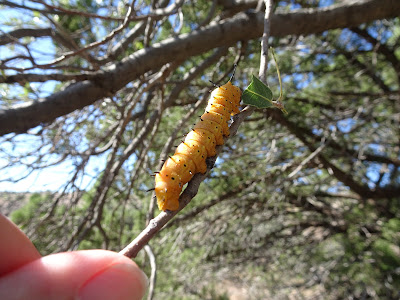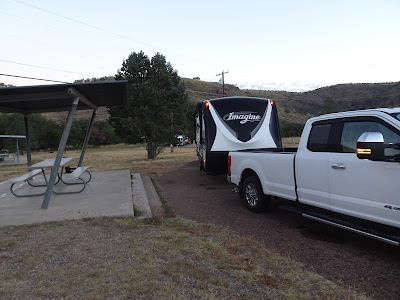From the title of the blog it’s probably no surprise that we’re at Goose Island State Park in Rockport. It’s my favorite Texas state park. This is the 2nd time we’ve been here this year.
It’s an easy four-hour drive from our house. Unfortunately, like most parks these days, it’s hard to get reservations.
We were lucky to get one of our favorite sites (#104) and pulled in about noon on a Sunday. Although we really like this site, we have discovered that it's not easy to load and unload the kayaks. The space is a little narrow. We have other "favorite" sites and will try one of them next time.
After unloading the trailer and the kayaks and getting everything set up, we headed into Rockport to our favorite Mexican food restaurant (Los Comales). We eat here every time we stay at Goose Island.
A lot of this area was destroyed or heavily damaged by hurricane Harvey in August 2017. One attraction that was destroyed was the Big Blue Crab in Veterans Park.
The first big blue crab was built in 1957 and sat on top of a restaurant until 1965 when the restaurant closed and the crab was moved to Navigation Park (now Veterans Park). This first crab survived Hurricane Beulah in 1967 and Hurricane Celia in 1970 but was so deteriorated it had to be removed.
The second crab was installed in August 2012. It didn’t survive Hurricane Harvey in 2017, a category 4 hurricane with 150 mph winds.
Three months after Harvey, fundraising began.
Big Blue Crab #3 arrived in Rockport July 2021. It weighs 6000 pounds and is made of stainless steel and is powder coated.
If you think the Big Blue Crab looks green, you are right. The blue comes from the color of the legs, not the body.
It looks great. There is still brickwork and landscaping to be done but I am glad to see the Big Blue Crab back where it belongs.
We headed back to Goose and spent the rest of the afternoon sitting outside and enjoying the nice weather.
Right before sunset we went for a walk and saw a few birds, including a Great Horned Owl. The White-tailed Deer are rutting (breeding) this time of year, and we saw several bucks.
Day 2:
According to the National Weather Service, today was going to be the only day without strong winds. So, we loaded up the kayaks and headed to the Lighthouse Lakes Paddling Trail. It was the very first Texas Paddling Trail and is a series of four loops ranging in length from 1.25 miles to 6.8 miles.
We were going to go to our favorite seafood restaurant (Shempy’s)
but they had posted their Winter hours on the door and were not open on Monday’s. Instead, we headed to our second favorite
Mexican food restaurant (Arandas Mexican Grill). Unfortunately, it wasn’t very good today. Maybe we need to try some new restaurants
every once in a while!
After lunch we headed into the downtown area of Rockport. I wanted to look in a few of the souvenir shops. Now that we have a house bigger than a 5th wheel, I’m free to buy a few things. I didn’t get much but I did find a few treasures.
We returned to the trailer late in the afternoon. We took a short walk down to the bird feeders but the mosquitoes were pretty bad and the sun was going down fast.
It’s mid-November but we’re still getting into the low 80’s during the day and not cooling off much at night.
Day 3:
We were up and out early this morning. For some reason we thought it would be light at 6 am. It wasn’t, but by the time we drove to the ferry in Port Aransas and parked at the Leonabell Turnbull Birding Center, it was plenty light.
The Leonabell Turnbull Birding Center is a favorite place of ours and there were plenty of birds to be seen.
We spent a few hours here then drove to a couple of other birding sites in Port Aransas.
Shempy's was open so we headed there for a late lunch (popcorn shrimp bait bucket for me, shrimp po-boy for Mark). It was excellent, as usual.
We headed down to the 1000' long fishing pier in the evening to see what was being caught. The fishermen weren't having much luck, but we enjoyed watching the sunset.
Day 4:
We birded around the area of the state park but the birding seems to be a little slow right now.
In a large field used to graze cattle, we did see Cattle Egrets demonstrating how they got their name.
After a wonderful lunch at Butterchurn (buffet) in Aransas Pass, we drove around to do a little sightseeing. The construction in Rockport is off the charts! It’s really heartbreaking to see this area being covered in houses, condos, and rv parks. This certainly isn’t a sleepy little town by the sea any more.
There are more than just birds in the waters.
You might remember the stacks of oyster shells that I posted a picture of in December 2020. This place buys oysters right off the boats and shucks them. A conveyer belt moves the shells out the back of the building. In 2020 a gallon of oysters costs $71. In 2021 the price has gone up to $76. Not much of an increase considering the price of other things these days.
However, their shucked shell stack has increased greatly during the past year.
November 2020:

November 2021:
Day 5:
What a difference a day makes! The weather turned very windy and a little cool and cloudy.
We wanted to go back to Leonabell Turnbull in Port Aransas. On the drive to the ferry it sprinkled on and off. We got on the ferry very early but the weather just wasn’t cooperating today.
We didn’t stay long. I wanted to hit a few souvenir shops. There are some interesting ones!
I did find a few things to purchase.

Lunch was once again at Los Comales. It was excellent. I usually order a dish called Enchiladas Tarascas. It is chicken enchiladas with a creamy mushroom sauce on top. Mark tries different dishes and they are always good.
We drove on back to Goose Island and started packing up
for the trip home the next day.
Our next trip is coming soon. We’ve got it planned and are ready to hit the road. Stay tuned!


































































